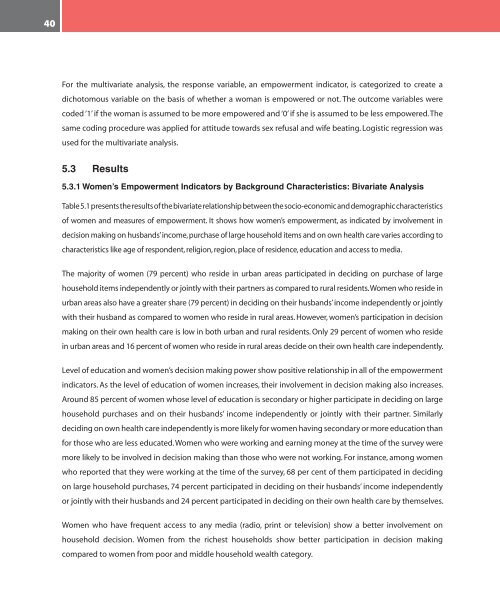Gender Inequality and Women's Empowerment - UNFPA Ethiopia
Gender Inequality and Women's Empowerment - UNFPA Ethiopia
Gender Inequality and Women's Empowerment - UNFPA Ethiopia
You also want an ePaper? Increase the reach of your titles
YUMPU automatically turns print PDFs into web optimized ePapers that Google loves.
40<br />
In-depth Analysis of the <strong>Ethiopia</strong>n Demographic <strong>and</strong> Health Survey 2005<br />
For the multivariate analysis, the response variable, an empowerment indicator, is categorized to create a<br />
dichotomous variable on the basis of whether a woman is empowered or not. The outcome variables were<br />
coded ‘1’ if the woman is assumed to be more empowered <strong>and</strong> ‘0’ if she is assumed to be less empowered. The<br />
same coding procedure was applied for attitude towards sex refusal <strong>and</strong> wife beating. Logistic regression was<br />
used for the multivariate analysis.<br />
5.3 Results<br />
5.3.1 Women’s <strong>Empowerment</strong> Indicators by Background Characteristics: Bivariate Analysis<br />
Table 5.1 presents the results of the bivariate relationship between the socio-economic <strong>and</strong> demographic characteristics<br />
of women <strong>and</strong> measures of empowerment. It shows how women’s empowerment, as indicated by involvement in<br />
decision making on husb<strong>and</strong>s’ income, purchase of large household items <strong>and</strong> on own health care varies according to<br />
characteristics like age of respondent, religion, region, place of residence, education <strong>and</strong> access to media.<br />
The majority of women (79 percent) who reside in urban areas participated in deciding on purchase of large<br />
household items independently or jointly with their partners as compared to rural residents. Women who reside in<br />
urban areas also have a greater share (79 percent) in deciding on their husb<strong>and</strong>s’ income independently or jointly<br />
with their husb<strong>and</strong> as compared to women who reside in rural areas. However, women’s participation in decision<br />
making on their own health care is low in both urban <strong>and</strong> rural residents. Only 29 percent of women who reside<br />
in urban areas <strong>and</strong> 16 percent of women who reside in rural areas decide on their own health care independently.<br />
Level of education <strong>and</strong> women’s decision making power show positive relationship in all of the empowerment<br />
indicators. As the level of education of women increases, their involvement in decision making also increases.<br />
Around 85 percent of women whose level of education is secondary or higher participate in deciding on large<br />
household purchases <strong>and</strong> on their husb<strong>and</strong>s’ income independently or jointly with their partner. Similarly<br />
deciding on own health care independently is more likely for women having secondary or more education than<br />
for those who are less educated. Women who were working <strong>and</strong> earning money at the time of the survey were<br />
more likely to be involved in decision making than those who were not working. For instance, among women<br />
who reported that they were working at the time of the survey, 68 per cent of them participated in deciding<br />
on large household purchases, 74 percent participated in deciding on their husb<strong>and</strong>s’ income independently<br />
or jointly with their husb<strong>and</strong>s <strong>and</strong> 24 percent participated in deciding on their own health care by themselves.<br />
Women who have frequent access to any media (radio, print or television) show a better involvement on<br />
household decision. Women from the richest households show better participation in decision making<br />
compared to women from poor <strong>and</strong> middle household wealth category.


